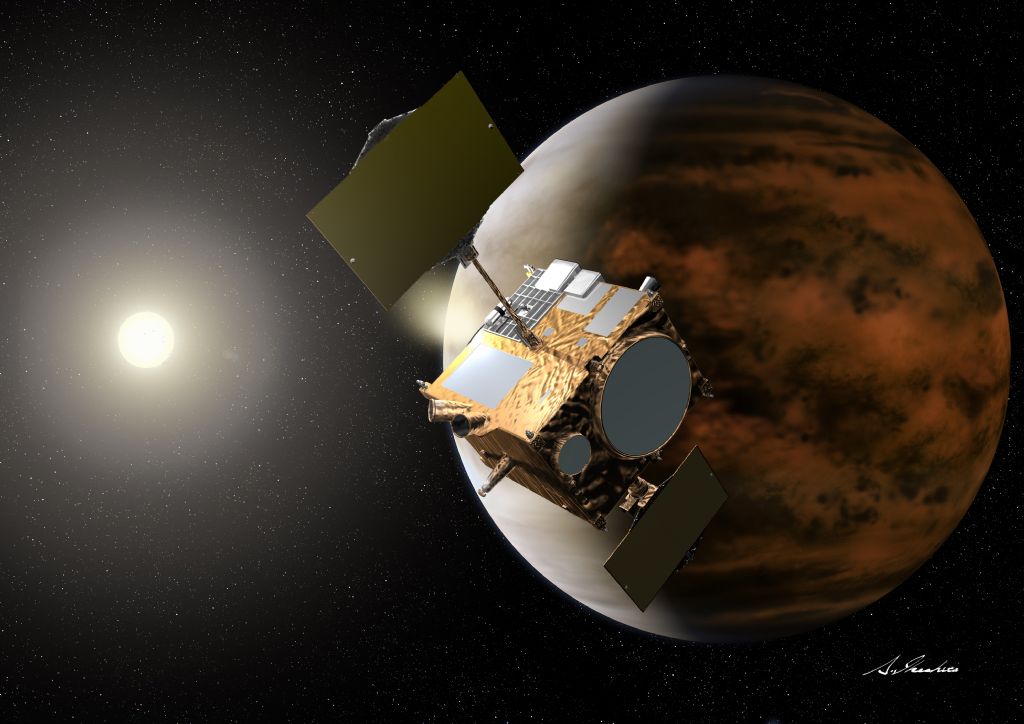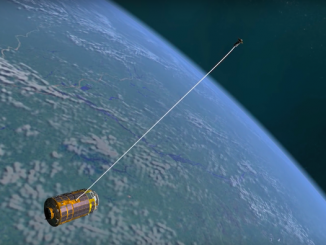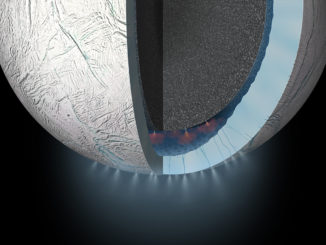
Five years after a balky valve kept it from entering orbit around Venus, Japan’s Akatsuki space probe is again approaching the sweltering planet for another shot at completing its science mission in December, officials said Friday.
The robotic spacecraft has spiraled around the inner solar system since it missed Venus in December 2010, as engineers on the ground meticulously planned for another chance to loop into orbit around Earth’s sister planet this year.
Akatsuki is on track for a critical maneuver Dec. 7 to position the spacecraft for capture by planet’s gravity, allowing the probe to enter an egg-shaped orbit stretching several hundred thousand miles from Venus at its farthest point — up to five times the planet’s diameter.
The Japan Aerospace Exploration Agency released the $300 million mission’s new flight plan Friday.
The orbit now planned for Akatsuki is much higher than the orbit originally selected for the mission. Instead of taking about 30 hours to complete a lap around Venus — as was planned after the botched 2010 arrival — Akatsuki will complete one orbit every eight or nine days.
Akatsuki, which means dawn in Japanese, will use its less powerful attitude control thrusters for the orbit insertion maneuver in December. Its main engine is offline after it overheated and switched off early during the mission’s December 2010 encounter with Venus.
Japanese engineers narrowed the cause of the anomalous engine burn, which lasted less than three minutes of a planned 12 minutes, to a blockage in a check valve inside the spacecraft’s propulsion system.
The suspect valve located between Akatsuki’s fuel and helium pressurant tanks cut off the flow of fuel to the engine, starving it of fuel and creating an oxidizer-rich combustion condition, raising temperatures inside the engine before it failed.
Officials believe an unexpected salt formation caused the problem with the valve, rendering the craft’s main engine useless.
Ground controllers are turning to Akatsuki’s eight attitude control thrusters to drive the probe into orbit around Venus. The small rocket jets each generate 5 pounds of thrust, a fraction of the impulse provided by the 112-pound thrust main engine.
The smaller rocket thrusters do not need the oxidizer launched with Akatsuki for the spacecraft’s main engine, so engineers commanded the probe to dispose of 143 pounds (65 kilograms) of the unnecessary propellant in 2011. The propellant dump reduced the mass of Akatsuki, giving the attitude control thrusters more ability to maneuver the spacecraft.
Akatsuki launched in May 2010 on its planned half-year journey to Venus.
The mission’s extended cruise has subjected the spacecraft to harsh temperatures beyond the design limits of some components on Akatsuki.
“On the current orbit, the orbiter has been exposed to heat that is about three times hotter than that of the Earth, thus we are concerned if some instruments might have been damaged,” officials wrote in an update posted to JAXA’s website in January. “Fortunately, the deterioration rate of the thermal insulation material has been subsided and we are now planning to control the Akatsuki to inject it into the Venus orbit while monitoring the conditions of the orbiter including the temperature of each instrument and part.”
Akatsuki was designed to observe climate and weather conditions on Venus with a suite of five cameras to look at low-altitude cloud patterns, chart the distribution of water vapor and carbon monoxide, and map the surface of Venus with a goal of finding active volcanoes. Thick clouds prevent visible cameras from seeing the surface.
A long-wavelength infrared camera and an ultraviolet instrument are aboard Akatsuki to study the super-rotating cloud structures in the upper atmosphere. The ultraviolet camera will also track sulfur dioxide, a precursor to cloud formation at Venus.
“After being injected into the orbit, the Akatsuki will observe the atmosphere of Venus, which is often referred to as a twin sister of the Earth, through remote sensing,” JAXA said in a statement released Friday. “Its observations are expected to develop ‘Planetary Meteorology’ further by elucidating the atmospheric circulation mechanism and studying the comparison with the Earth.”
At its farthest point from Venus in each orbit, Akatsuki will “continuously observe Venus as a whole to understand its clouds, deep atmosphere and surface conditions.”
“When flying closer to Venus … the orbiter will conduct close-up observations to clarify cloud convection, the distribution of minute undulatory motions and their changes,” JAXA said Friday.
Akatsuki will study cloud layers in the Venusian atmosphere when the probe is closest to the planet, and it will search for lightning when above the night side of Venus, officials said.
Scientists originally planned to conduct tandem observations of Venus with Akatsuki and the European Space Agency’s Venus Express spacecraft, but the ESA probe ran out of propellant in late 2014 and has likely burned up in the Venusian atmosphere.
Follow Stephen Clark on Twitter: @StephenClark1.



